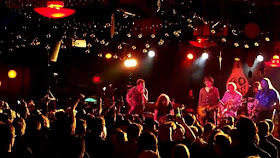The
Coming Storm
It is not just about the climate. It is also a political storm. If Trump wins in the coming election, the level of class conflict will go sky-high throughout the U.S. for years. If Trump wins, the Democratic Party will be in tatters ideologically, and they will not be able to blame Russia, China or Jill Stein this time - though they will try. Their endless con-job as the ‘party of the people’ will be laid to waste. If Trump wins, conditions in the U.S. will become even closer to an authoritarian police state, with fascists allied with the forces of repression, posing a huge question for the left, workers, unions and minorities. If Trump wins, leftists, minorities, ‘outsiders’ of any kind will be open targets. Right now we are already seeing the beginnings of open fascist killings and armed self-defense by the left, with racist cops and sheriffs backing the white right.
It is not just about the climate. It is also a political storm. If Trump wins in the coming election, the level of class conflict will go sky-high throughout the U.S. for years. If Trump wins, the Democratic Party will be in tatters ideologically, and they will not be able to blame Russia, China or Jill Stein this time - though they will try. Their endless con-job as the ‘party of the people’ will be laid to waste. If Trump wins, conditions in the U.S. will become even closer to an authoritarian police state, with fascists allied with the forces of repression, posing a huge question for the left, workers, unions and minorities. If Trump wins, leftists, minorities, ‘outsiders’ of any kind will be open targets. Right now we are already seeing the beginnings of open fascist killings and armed self-defense by the left, with racist cops and sheriffs backing the white right.
If Trump loses, Trump’s fascist militias will come out and try to occupy state capitols to support Bill Barr’s attempt to guide the election away from the Electoral College into a single-state vote in the House of Representatives; or by Republicans nullifying some states' votes they control and choosing their own electors. In the process, violence will be inevitable against all Republican enemies. It will be an open season of anger. If Trump loses, Biden will be unable to carry out anything for the working class of whatever skin color. Social conditions will continue to deteriorate. If Trump loses, a more effective and intelligent Trump will be promoted by the Republican Party while Biden practices patty-cake ‘bi-partisanship’ with them. Tucker Carlson might be their next candidate!
Whatever happens, it will not be pretty. So the
boy scout motto, minus the pedophilia, is ‘Be Prepared.’ Prepare for a defense against fascist
violence. Prepare with other people.
The
second part is to build a united social movement with a political arm – a Left Front
among the hard-left factions; a 3rd leftist or populist party like
the Movement for a People’s Party; a Labor Party based on the unions; an Anti-Fascist Front ready to stop fascist mobilizations. A divided and amorphous ‘resistance’ movement
with little organization, transitional demands or limited goals cannot handle the
coming storm or its aftermath to actually move the dial towards massive social
change. Things will stay the same with this kind of approach. The unions have to stop kow-towing to
Democrats and look to strike action. The BLM movement has to chart a path
towards class struggle. Socialists
have to unite on a basic platform. The
so-called ‘left’ in the Democratic Party has to prepare to break and unite with
those who are charting an independent, working-class course.
Whether any of this is possible is another question. A moment
in class-struggle history is coming.
Those who don’t understand will be overwhelmed and defeated. Those who do understand can intervene and move society to the left.
Watch People's Convention Now: https://www.youtube.com/watch?v=t6u5xPJaW2s
Watch People's Convention Now: https://www.youtube.com/watch?v=t6u5xPJaW2s
Red Frog
August
30, 2020







